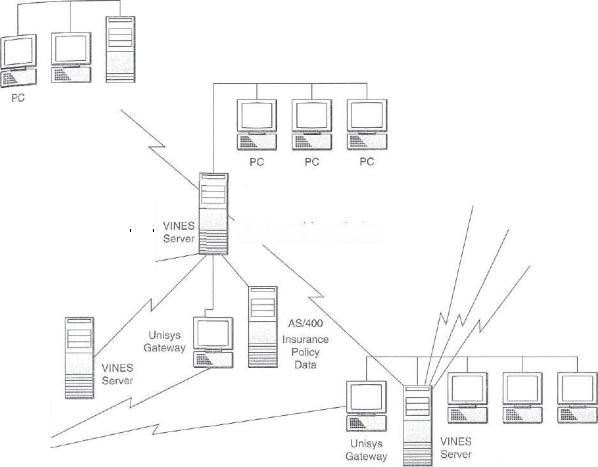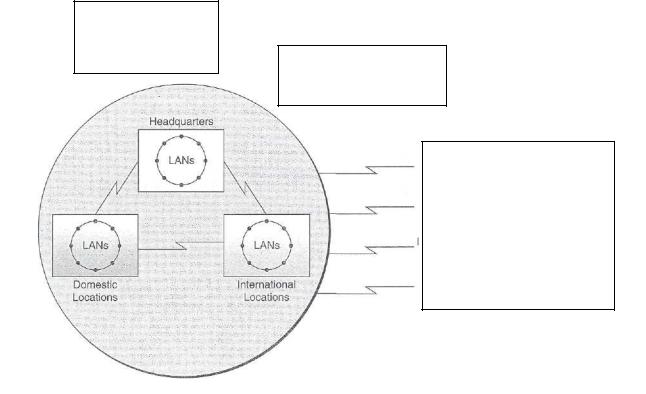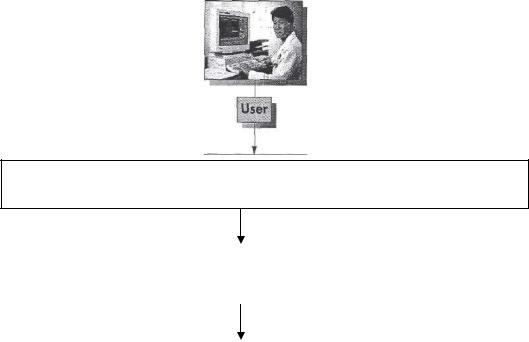
Англ язык Защита информации
.pdf
peer-to-peer communication – связь между одинаковыми по состоянию устройствами
bridge – мост; соединять
gateway –шлюз, межсетевой интерфейс bus – шина
FDDI (Fiber Distributed Data Interface) – интерфейс для передачи данных по волоконно-оптическим каналам
under heavy use – при интенсивном использовании the flow of traffic – поток трафика
to prevent collision between messages – предотвращать столкновения конфликтов между сообщениями
high resolution graphics – графика с высокой разрешающей способностью
Exercises
Comprehension Check
Exercise 1. Answer the following questions
1. What may communication channels and hardware have? 2. Speak about features of networks. 3.What do networks allow users to do? 4. What is a network? 5. What types of networks do you know? 5. How does WAN function? 6. What is a purpose of a network? 7. Who do local networks serve? 8. What are computer networks served by? 9. Give a definition of a server. 10. What is a node? 11. What types can local networks be divided into? 12. What topology may LAN take? 13. A private branch exchange is the old-fashioned company switchboard, isn’t it? 14. What does the word “peer” denote? 15. Are peer-to peer networks more expensive than client/server networks? 15. What are standard networks made up of? 16. Speak about LAN topologies. 17. What is the impact of LANs?
Exercise 2. Match the terms in Table A with its definitions in Table B
Table A
1.A network
2.A host
3.Hybrid networks
4.A server
5.A bridge
6.A gateway
7.A node
8.PBX
9.A peer-to-peer LAN
10.Wireless networks
Table B
a)is a private or leased telephone switching system that connects telephone extensions in-house
b)is an interface that enables similar networks to communicate
c)is an interface that enables dissimilar networks to communicate, such as a LAN with a WAN
d)is a computer shared by several users in a network
e)are combinations of star, ring, and bus networks
21

f)are subject to interference
g)is the central computer that controls the network
h)is one in which all microcomputers on the network communicate directly with one another without relying on a server
i)is a system of interconnected computers, or communications network, telephones, or other communications devices that can communicate with one another and share applications and data
j)is a device that is attached to a network
Exercise 3. Find the corresponding ending for the following statements
1. |
Download means |
A client/server or peer-to-peer and include |
|
|
components such as cabling, network |
|
|
interface cards, an operating system, other |
|
|
shared devices, and bridges and gateways. |
2. |
A private branch exchange |
D is the old-fashioned company switchboard. |
3. |
LANs may be |
C require installation of their own |
|
|
communication channels, whether wired or |
|
|
wireless. |
4. |
LANs |
D include printers, scanners, and storage |
|
|
device. |
5. Wireless networks |
E that you send files from your computer to |
|
|
|
another computer. |
6. |
A network interface card |
F enables the computer to send and receive |
|
|
messages on the LAN. |
7. Shared hardware |
G are subject to interference. |
|
8. Local area networks |
H direct calls to different branches of the |
|
|
|
network. |
9. |
Public branch exchanges |
I that you retrieve files from another |
|
|
computer and store them in your computer. |
10. Upload means |
J do not use the telephone network. They use |
|
|
|
some other cabling or connection system |
Language work
Exercise 1. Complete the following sentences with the verbs in the corresponding form:
To manage, to monitor, to prevent, to be connected, to be linked to, to transmit, to use:
1.In a bus network each communications device ………. electronic messages to other
devices.
2.The hub ……… collisions between messages.
3.The network operating system software ……….the activity of the network.
4.In a star network, all the network's devices………… to a central server.
5.In a ring network all microcomputers and other communications devices ………. in a continuous loop.
6.The central hub ……… the flow of traffic.
7.FDDI network ……… fiber-optic cable with an adaptation of ring topology.
22

The function of an item
We can describe the function of an item differently. Study the following examples.
With the help of the Present Simple.
1.Cache controller looks after cache coherency.
Used to-infinitive, Used for+ing form
2.Cache controller is used to look after cache coherency. 3.Cache controller is used for looking after cache coherency.
Emphasizing the function
4.The function of a cache controller is to look after cache coherency.
(From William Saywer Hutchinson. Using Information Technology)
Exercise 2.Describe the functions of these items in two ways
1. |
A mouse |
6. |
Clock |
2. |
Slot cards |
7. |
PDA |
3. |
CPU |
8. |
Barcodes |
4. |
Monitor |
9. |
Scanner |
5. CD-ROM drive |
10. ATM |
||
Discuss the following problems
Exercise 1.Share into groups. List the advantages and disadvantages of a network Compare your answers.
Advantages of a network |
Disadvantages of a network |
|
|
Exercise 2. Write the instruction for assembling a LAN
Text 5. CLIENT / SERVER COMPUTING
Client/server computing has become the model for a new information architecture that will take enterprisewide computing into the 21st century. Computing power has rapidly become distributed and interconnected throughout many organizations through networks of all types of computers. More and more, networked computer systems are taking the form of client/server networks. In a client/server network, end user microcomputer workstations are the clients. They are interconnected by local area networks and share application processing with LAN servers, which also manage the networks. These local area networks may also be interconnected to other LANs and wide area networks of client workstations and servers. See Figure 5.
With client/server computing, end users at client LAN workstations can handle a broad range of information processing tasks. They can thus perform some or most of the processing of their business applications. This includes data entry and other user interface activities, inquiry response, transaction processing, updating databases, generating reports, and providing decision support. LAN severs can share application processing, manage work group collaboration, and control common hardware, software, and databases. Thus, data can be completely processed locally, where most input and output (and errors and problems) must be handled anyway, while still providing access to the workstations and servers in other networks. This provides computer processing more tailored to the needs of end users and increases information processing efficiency and effectiveness as users become more responsible for their own applications systems.
Client/server computing also lets large central-site computers handle those jobs they can do best, such as high-volume transaction processing, communications, network security and control, and maintenance and control of large corporate databases. User clients at local sites can access these superservers to receive corporatewide management information or transmit summary transaction data reflecting local site activities.
23

Client/server computing is the latest form of distributed processing. In distributed processing, information processing activities in an organization are accomplished by using a network of computers interconnected by telecommunications links instead of relying on one large centralized computer facility or on the decentralized operation of several independent computers. For example, a distributed processing network may consist of mainframes, minicomputers, and microcomputers, dispersed over a wide geographic area and interconnected by wide area networks. Or it may take the form of a client/server network of end user workstations and network servers distributed within user departments in interconnected local area networks.
Client/server computing may also involve cooperative processing. Cooperative processing allows the various types of computers in a distributed processing network to share the processing of parts of an end user's application. Application software packages are available which have common user interfaces and functions so they can operate consistently on networks of micro, mini, and mainframe computer systems. For example, an end user could use a spreadsheet package provided to his or her microcomputer workstations by a local area network server to perform financial analysis on databases managed by a corporate mainframe.
FIGURE 5. A client/server model for distributed and cooperative processing. Note the functions performed by different types of computers acting as clients, servers, and superservers for the Westland Group; a Wisconsin banking and insurance company
|
|
|
|
|
|
|
|
|
|
|
|
Tomah |
|
|
|
|
|
|
|
|
|
|
|
|
|
|
|
|
|
|
Administration |
|
|
|
|
|
|
|
|
|
|
|
|
|
|
|
|
|
|
|
|
Center |
|
|
|
|
|
|
|
|
|
|
|
|
|
|
|
|
|
|
|
|
|
|
|
|
|
|
|
|
|
|
|
|
|
|
|
|
|
|
|
|
|
|
|
|
|
|
|
|
|
Insurance Rating |
|
|
|
|
|
|
|
|
|
|
|
||||||
|
|
Applications |
|
|
|
|
|
|
|
|
|
|
|
||||||
|
|
|
|
|
|
|
|
|
|
|
|
|
|
|
|
|
|
|
|
|
|
|
|
|
|
|
|
|
|
|
|
|
|
|
|
|
|
|
|
Branch Of-fice |
|
|
|
|
|
|
|
|
|
|
|
|
|
|
|
|
|||
|
|
|
|
|
|
|
|
|
|
Elroy Branch |
|
|
|
|
|||||
|
|
UNIX |
|
|
|
|
|
|
|
|
|
|
|
||||||
|
|
|
|
|
|
|
|
|
|
|
|
|
|||||||
(in-surance |
|
|
|
|
|
|
|
|
|
|
|
|
|||||||
|
|
Server |
|
|
|
|
|
|
|
|
|
|
|
|
|
||||
only) |
|
|
|
|
|
|
|
|
|
|
|
|
|
|
|||||
|
|
Office Productivity Applications |
|
|
|
|
|
||||||||||||
|
|
|
|
|
|
|
|
|
|
|
|
|
|||||||
|
|
|
|
|
|
|
Adams Branch |
|
|||||||||||
|
|
|
|
|
|
|
|
|
|
||||||||||
|
|
|
|
|
|
|
|
|
|
||||||||||
|
|
|
|
|
|
Core |
|
|
|
|
Insurance Rating Applications |
|
|
||||||
|
|
|
|
|
|
|
|
|
|
|
|
|
|
||||||
|
|
|
|
|
|
|
|
|
|||||||||||
|
|
|
|
|
|
|
|
|
|||||||||||
|
|
|
|
|
Insurance |
|
|
|
|
|
|
|
|
|
|
|
|||
|
|
|
|
|
|
|
|
|
|
|
|
|
|
||||||
|
|
|
|
|
|
|
|
|
|
|
New Lisbon Branch |
||||||||
|
|
|
|
Applications |
|
|
|
|
|
|
|
|
|||||||
|
|
|
|
|
|
|
|
|
|
|
|
|
|
|
|
|
|
|
|
|
|
|
|
|
|
|
|
|
|
|
|
|
|
|
|
|
|
|
|
|
|
|
|
|
|
|
|
|
|
|
|
|
|
|
|
|
|
|
|
|
Unisys Mainframe |
Insurance Rating Applications |
||
|
Core Banking Applications |
|||
|
Banking Applications |
|||
|
|
|
Office Productivity Applications |
|
|
|
|
||
|
|
|
|
|
|
Main Office |
|
|
|
|
|
|
Mauston Branch Office |
|
|
|
|
|
|
|
|
|
|
(Banking and Insurance) |
|
|
|
|
|
|
|
|
|
|
24

Many of the applications of telecommunications we have just mentioned can be classified as inter-organizational networks. As Figure 6 illustrates, such networks link company's wide area and local area networks to the networks of its customers, suppliers, information service providers, and other organizations. For example, you can think of a computerized account inquiry system for access by customers as an example of an interorganizational network. So is the use of electronic document interchange, which links the computers of a company with its suppliers and customers. Accessing information services such as Dow-Jones News Retrieval or the data banks of government agencies for information about market and economic conditions is another example. Electronic funds transfer applications also depend on: interorganizational networks established among banks, businesses, employees, customers, and suppliers.
FIGURE 6. Interorganizational systems rely on network links between an organization and its customers, suppliers, and other organizations
Company
Wide Area
Networks Interorganizational
Network Links
Customers
Suppliers
Information Services
Other Organizations
Thus, the business use of telecommunications has moved beyond the boundaries of work groups and the organization. Now many business firms have extended their telecommunications networks to their customers and suppliers, both domestically and internationally. Such interorganizational systems build new strategic business relationships and alliances with those stakeholders in an attempt to increase and lock in their business, while locking out competitors. Also, transaction processing costs are frequently reduced, and the quality of service increases. In addition, the availability of external information about industry, market, economic, and political developments provides better information for managerial decision making. Because of these benefits, the trend toward increased connectivity between the networks of an organization and its external stakeholders is expected to continue.
(From James A. O’Brien. Management Information Systems)
25

List of words and expressions
client/server computing – обработка информации между клиентом и сервером, компьютер клиент-сервер
data entry – ввод данных
inquiry response – ответ на запрос transaction processing – обработка запроса to update – обновлять, модернизировать tailored – приспособленный
summary transaction data – итоговые данные транзакции cooperative processing – объединенная обработка (информации) distributed processing network – сеть распределенной обработки retrieval – поиск, выборка
stakeholder - посредник
Exercises
Comprehension Check
Exercise 1. Put down problem questions to the text.
Exercise 2. Find the English equivalents in the text for the following:
стать моделью для новой информационной архитектуры, вычислительная мощь, сетевые компьютерные системы, конечный пользователь, рабочие станции, совместно использовать прикладные программы, управлять компьютерной сетью, справляться с широким перечнем информационных задач, коммерческие приложения, ввод данных, обновление баз данных, обеспечивать доступ к рабочим станциям и серверам других сетей, выполняться при помощи, иметься в наличии, использовать таблицы, электронный обмен документами, служащие, поставщики, выйти за пределы рабочих групп и организаций, создавать стратегические деловые отношения, улучшать качество услуг, доступность внешней информации, ввиду данных преимуществ, связуемость.
Exercise 3. Speak about client/server technology. Make a short oral summary. Present it to the class.
Language work
Passives
1.Police have installed VCRs on many roads.
2.Barcode just has been converted into electronic pulses.
In Sentence 1 the verb is active and in 2 it is passive, the Present Perfect Passive. Why? Is there any difference? In the first sentence the agent is responsible for the action (the police). In the 2 the agent is not mentioned? But you can guess that it is a scanner. The Passive is used to describe a situation where the action is more important than the agent.
(From James A. O’Brien. Management Information Systems)
26
Exercise 1. Choose the correct alternative in each of these sentences:
1.Many of the applications of telecommunications have just mentioned / have just been mentioned.
2.The trend toward high-speed, digital networks has captured / has been captured the interest of both business and government.
3.Computing power has become / has been become distributed and interconnected through networks of all types of computers.
4.These local area networks have interconnected / have been interconnected to other LANs and wide area networks lately.
5.Virtual work groups have already formed / have already been formed to work on joint projects.
Exercise 2. Look at the first sentence in each pair and highlight the passive verb forms. Then complete the second sentence, which is active:
1.a) A broad range of information processing tasks can be handled by end users at client LAN workstations.
b)End users at client LAN workstations …… a broad range of information processing tasks.
2.a) We were given the information we needed.
b)He …… us the information we needed.
3.a) Most of the processing of their business applications are performed.
b)They …… most of the processing of their business applications.
4.a) Information processing activities in an organization have been accomplished by using a network of computers.
b)We …… information processing activities in an organization by using a network of computers.
5.a) She was proud to have been promoted.
b)She was proud that they had …… her.
6.a) A spreadsheet package is being provided to his or her microcomputer workstations by a local area network server.
b)A local area network server …… a spreadsheet package to his or her microcomputer workstations.
Exercise 3. Rewrite the following sentences into Passive:
1.We use computer systems in a variety of work situations where earlier it was necessary to employ people.
2.Hospitals can increasingly use computers.
3.In airports highly trained experts use computers.
4.Police use speed traps to catch drivers breaking speed limits.
5.Large supermarkets have used computers for decades already.
6.Scanner devices called barcode readers convert barcodes into prices.
7.The till prints the item and the price on the paper receipt.
8.We refer to one character of data as a byte.
9.Asynchronous transmission sends the data one byte or character at a time.
10.In a client/server network, the main server computer provides the services (sharing of printers, programs or data, etc).
11.Terminals require the server to do most or all of the processing.
27
12.The hub connects all electronic devices.
13.A simple computer comprises a processor and memory, display, keyboard, mouse and a hard disk drive.
14.A backbone, i.e. a network transmission path, handles major data traffic.
15.A special computer, called a router, directs messages when we link several
networks.
Discuss the following problems
Exercise 1. What can be done to minimize the disadvantages of LANs using. Divide into groups, discuss and put down your notes. Share your points with your classmates.
28

Unit II. SYSTEMS SOFTWARE
Text 1. The Operating System
An operating system is required for applications software to run on your computer. The user usually works with the applications software but can bypass if to work directly with the systems software for certain tasks.
The operating system (OS) consists of the master system of programs that manage the basic operations of the computer. These programs provide resource management services of many kinds, handling such matters as the control and use of hardware resources, including disk space, memory, Central Processor Unit (CPU) time allocation, and peripheral devices. The operating system allows you to concentrate on your own tasks or applications rather than on the complexities of managing the computer.
FIGURE 7. The three types of systems software
Applications Software
word processing, spreadsheet, communications, database, graphics, etc.
External |
|
|
Systems Software |
|
|
Language |
utility |
|
|
Operating System |
|
|
translators |
programs |
|
|
|
|
|
|
|
|
|
|
|
|
|
|
|
|
|
|
|
|
|
|
|
|
|
|
|
|
|
|
Hardware |
|
|
|
|
|
|
(computer plus peripheral |
|
|
|
|
|
|
devices) |
|
|
|
|
|
|
|
|
|
|
Different sizes and makes of computers have their own operating systems. For example, Cray supercomputers use UNICOS and COS, IBM mainframes use MVS and VM, Data General minicomputers use AOS and DG, and DEC minicomputers use VAX/VMS. Pen-based computers have their own operating systems—PenRight, PenPoint, Pen DOS, and Windows for Pen Computing—that enable users to write scribbles and notes on the screen. These operating systems are not compatible with one another. That is, in general, an operating system written for one kind of hardware will not be able to run on another kind of machine.
Microcomputer users may readily experience the aggravation of such incompatibility when they buy a new microcomputer. Should they get an Apple Macintosh with Macintosh
29
Systems Software, which won't run IBM-compatible programs? Or should they get an IBM or IBM-compatible (such as Compaq, Dell, or Zenith), which won't run Macintosh programs? And, if the latter, should they buy one with DOS with Windows, Windows 95, OS/2, Windows NT, or Unix? Should they also be concerned with an operating system such as NetWare that will link several computers on a local area network? Should they wait for a new operating system to be introduced that may resolve some of these differences?
Before we try to sort out these perplexities, we should see what operating systems do that deserves our attention. We consider:
−Booting
−Housekeeping tasks
−User interface
−Managing computer resources
−Managing files
−Managing tasks
The operating system begins to operate as soon as you turn on, or "boot," the computer. The term booting refers to the process of loading an operating system into a computer's main memory from diskette or hard disk. This loading is accomplished by a program (called the bootstrap loader or boot routine) that is stored permanently in the computer's electronic circuitry. When you turn on the machine, the program obtains the operating system from your diskette or hard disk and loads it into memory. Other programs called diagnostic routines also start up and test the main memory, the central processing unit, and other parts of the system to make sure they are running properly. As these programs are running, the display screen may show the message "Testing RAM" (main memory). Finally, other programs (indicated on your screen as "BIOS," for basic inputoutput system) will be stored in main memory to help the computer interpret keyboard characters or transmit characters to the display screen or to a diskette.
All these activities may create a jumble of words and numbers on your screen for a few seconds before they finally stop. Then a guide may appear, such as "A:\>" or "C:\>." This is the system prompt. The system prompt indicates the operating system has been loaded into main memory and asks ("prompts") you to enter a command. You may now enter a command. The operating system remains in main memory until you turn the computer off. With newer operating systems, the booting process puts you into a graphically designed starting screen, from which you choose the applications programs you want to run.
If you have not entered a command to start an applications program, what else can you do with the operating system? One important function is to perform common repetitious "housekeeping tasks."
One example of such a housekeeping task is formatting blank diskettes. Before you can use a new diskette that you've bought at a store, you may have to format it. Formatting, or initializing, electronically prepares a diskette so it can store data or programs.
(From Williams Sawyer Hutchinson. Using Information Technology)
List of words and expressions
master system – базовая (главная) система
resource management service – услуга управления ресурсами disk space – место на дискe
CPU time allocation – распределение времени центрального универсального процессора
30
